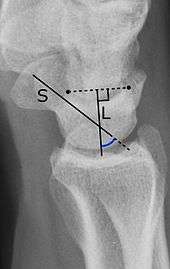Dorsal intercalated segment instability
Dorsal intercalated segment instability (DISI) is a deformity of the wrist where the lunate angulates to the posterior side of the hand.[2][3]

The SL angle is an indicator of dorsal intercalated segment instability deformity (DISI). The SL angle goes between:[1]
- A line through the long axis of the scaphoid bone.
- A line perpendicular to the distal articular surface of the lunate bone.
It should normally be 30°-60°.[1]
- A line through the long axis of the scaphoid bone.
- A line perpendicular to the distal articular surface of the lunate bone.
It should normally be 30°-60°.[1]
Causes
The main causes of DISI are:[4]
- Wrist trauma, with or without a fracture
- Scaphoid fracture: bony DISI
- Distal radius fracture: compensatory DISI
- Malunion of radius fracture: adaptive DISI
- Scapholunate ligament instability: ligamentous DISI
References
- Page 75 in: Leiv M. Hove, Tommy Lindau, Per Hølmer (2014). Distal Radius Fractures: Current Concepts. Springer. ISBN 9783642546044.CS1 maint: multiple names: authors list (link)
- Shah, CM; Stern PJ (2013). "Scapholunate advanced collapse (SLAC) and scaphoid nonunion advanced collapse (SNAC) wrist arthritis". Current Reviews in Musculoskeletal Medicine. 6 (1): 9–17. doi:10.1007/s12178-012-9149-4. PMC 3702758. PMID 23325545.
- Omori, S; Moritomo, H; Omokawa, S; Murase, T; Sugamoto, K; Yoshikawa, H (July 2013). "In vivo 3-dimensional analysis of dorsal intercalated segment instability deformity secondary to scapholunate dissociation: a preliminary report". The Journal of Hand Surgery. 38 (7): 1346–55. doi:10.1016/j.jhsa.2013.04.004. PMID 23790423.
- Yair Glick and Yuranga Weerakkody; et al. "Dorsal intercalated segment instability". Radiopaedia. Retrieved 2018-01-26.
This article is issued from
Wikipedia.
The text is licensed under Creative
Commons - Attribution - Sharealike.
Additional terms may apply for the media files.